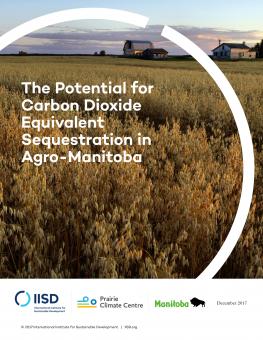
The Potential for Carbon Dioxide Equivalent Sequestration in Agro-Manitoba
IISD and the Prairie Climate Centre conducted a high-level quantitative analysis of the sequestration potential of land use practices in Agro-Manitoba that are additional to business as usual.
As the province of Manitoba moves toward a new climate policy paradigm, the land use-based practices in private, seeded lands within Agro-Manitoba present an opportunity to sequester or reduce net emissions.
To this end, the International Institute for Sustainable Development and the Prairie Climate Centre conducted a high-level quantitative analysis of the sequestration potential of land use practices in Agro-Manitoba that are additional to business as usual. The land use practices that were considered in this study include those related to wetlands, forestry, riparian buffers, minimum tillage, perennials and cover crops.
Participating experts
You might also be interested in
IISD Applauds Canada’s Reaffirmation to End Domestic Public Finance for Fossil Fuels in Budget 2024
Today's federal budget announcement delivers new measures to support affordability and reaffirms Canada’s commitments on climate action.
The Critical Next Step: What you need to know about Canada’s 2030 climate target
Canada's climate target for 2030 is within reach, but more stringent policies and clearer government communication will be needed to get there. Our expert explains why these developments are critical for Canada to help avoid the worst impacts of climate change.
Ottawa supports Big Oil over the climate
One can only imagine the positive buzz these days inside the boardrooms of Canada's oil companies, as they rake in record profits and plan major expansions of their oil production. Amid all the good cheer, one could easily lose sight of the fact that those plans will push the world dangerously closer to the brink of irreversible climate chaos. Even as the world finally signed a commitment at UN climate talks last month to begin transitioning away from fossil fuels, Canada's major oil companies are poised to do exactly the opposite — to greatly expand their fossil fuel production.
Feds and province veto offshore oil exploration in Nova Scotia
A licence to explore the offshore of Nova Scotia for oil and gas and restart fossil fuel activity there after years of dormancy was rejected Monday by the federal and provincial governments. The decision to reject the licence considers broader policy focused on "shared commitments to advance clean energy and pursue economic opportunities in the clean energy sector, which are beyond the scope of the board's regulatory purview," a joint statement said.